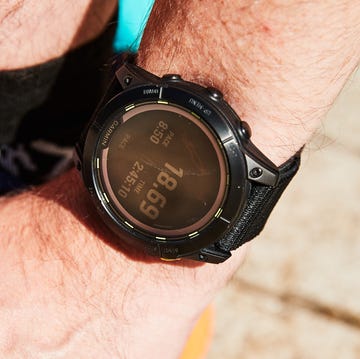Running watches have always been essential for athletes, but over the past decade and a half, the proliferation of smartwatches and other monitors has made these devices standard equipment for runners of all fitness levels.
While the devices may be as commonplace as running shoes on the road, new research suggests that certain smartwatch bands’ materials may harm humans. The study, by researchers at the University of Notre Dame, found that Per- and Polyfluoroalkyl Substances—otherwise known as PFAS, harmful chemicals that can be absorbed through the skin—were present in 15 popular brands of smartwatch bands out of 22 checked.
The rate at which PFAS are absorbed into the body through the skin is unknown, although research has found that this does occur. Since bands are pressed against wrists for a prolonged period, researchers called the study’s findings “concerning.”
The levels of PFAS detected in the bands were “much higher than most PFAS we have seen in consumer products,” Dr. Graham Peaslee, a study co-author, said.
PFAS are a group of approximately 15,000 synthetic chemicals commonly used to make products resistant to water, stains, and heat. They are called “forever chemicals” because they do not naturally break down and can accumulate in the environment and the human body. Exposure to PFAS has been linked to various serious health issues, including cancer, kidney disease, liver problems, immune disorders, and congenital disabilities.
While these compounds are commonly added to consumer products like rain jackets and hiking gear as waterproofing agents, researchers at the University of Notre Dame were surprised to find PFAS levels in some watches as high as those found in firefighting equipment. While natural rubber is unlikely to contain PFAS, the chemicals are often added to synthetic rubber products to prevent sweat stains and dirt buildup over time, such as those meant for wearing while working out.
While the study doesn’t identify which compounds contained them, it does say that the brands Apple, Fitbit, and Google were among the 22 tested. Researchers say that some brands do advise the use of PFAS—check for the term “fluoroelastomer band,” which indicates their use in the product.
The study analyzed individual PFAS compounds and found that PFHxA, a synthetic chemical within the PFAS group, had the highest concentration. PFHxA was detected in 40 percent of the samples. This chemical is commonly used in clothing, carpets, paper, and insecticides and has been linked to liver disease. PFHxA is an understudied PFAS compound because it is more difficult to detect in human blood than other PFAS. Researchers found PFOA, a compound that the EPA has determined has no safe level of exposure in drinking water.
Speaking with The Guardian, Peaslee offered up silicone as a safer option.
“I don’t need someone to rush to throw away their Christmas gifts, but next time you buy one, move away from those with PFAS,” Peaslee said.
Laura Ratliff is a New York City-based writer, editor, and runner. Laura's writing expertise spans numerous topics, ranging from travel and food and drink to reported pieces covering political and human rights issues. She has previously worked at Architectural Digest, Bloomberg News, and Condé Nast Traveler and was most recently the senior editorial director at TripSavvy. Like many of us, Laura was bitten by the running bug later in life, after years of claiming to "hate running." Her favorite marathon is Big Sur.













